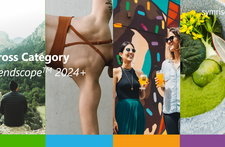By Brad Ross, Global Trends Forecasting
Years ago, in art school, I remember attending various gallery openings where the guests would arrive in their predictable all-black attire and pretentious smirks, while sipping red wine as they carefully studied and critiqued each piece. Today’s creative class, however, is refreshingly unassuming, reflecting all ages, and backgrounds. In fact, the 21st century creative class is exponentially growing and therefore bringing a substantial amount of power to the business/retail sector.
Take, for example, fabric weaving. Want to be a textile artist? Google it! Thanks to the internet, art forms and design realms once requiring years of training and apprenticeship, are now immediately accessible to the masses, allowing anyone to become a creator or maker.
CLICK HERE to view Trend Perspectives: 2016 Color Trends
With respectively more than 400 and 100 million active Instagram and Pinterest users, a new population of Creatives has arrived. Anyone from a stay-at-home mom to a retired grandpa can flex his/her creative muscles through video, filters, moodboards and playlists. While democracy is somewhat elusive, politically, the world wide web has undoubtedly managed to democratize creativity.

According to Steven Rodenbaum, author of, Curation Nation: How to Win in a World Where Consumers are Creators, we used to live in a world of distinct disciplines: “The senior editorial leadership at magazines were known as editors. The people who picked which things would be on the shelves of your local stores were retailers.” Rodenbaum explains that, today, curation is the coin of the realm, with consumers as the creators.

According to a report by Intuit, it’s estimated that by 2020, more than 40% of the American workforce will be independent workers – freelancers, contractors or temporary employees. Among these will arise the, “Hyphenated Creatives” – individuals with more than one creative pursuit, combining various gigs and side jobs into a greater career: the Kindergarten teacher who also has a part-time baking business, a Starbucks barista who models on the side, or the graphic designer who sidelines as a wedding photographer. Now the backbone of our freelance economy, this tribe is uniquely part-artist, part-entrepreneur.

And to assume that this trend is solely by and for Millennials would be grossly incorrect. The Baby Boomer generation, who created the 60-hour workweek, is discovering their creativity later in life and adding to a growing league of creative retirees. Career coaches unanimously agree that these late-bloomer creative entrepreneurs have a greater chance of succeeding than their younger counterparts, as their finances are typically in better shape, their personal life is more stable and they know what their weaknesses are.
As we roll into 2017 and beyond, we clearly see that the days of creative exclusivity are over; all are welcome and this new creative freedom is growing across the globe. Meanwhile, the nature of our professions is being altered by the democratized digital world; fueling a new creative class untethered by age, race or economic status. Through emerging technology, this new class will continue to challenge the prerequisites of traditional crafts, while offering unlimited opportunities. And it is here, now, that I smile, when contrasting my stuffy, art gallery days to my 11-year-old daughter, currently in her sweats, posting another DIY video on YouTube.
CLICK HERE for more trends and subscribe to the weekly in-sight newsletter!






